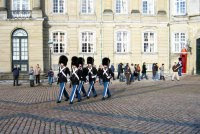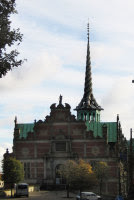
Tourists like to visit Copenhagen. It is the largest and while the style of life the most colorful, «South» and cheerful little prudish among Scandinavian capitals - Oslo and Stockholm. Capital of Denmark has a long history, of course, that there lot of interesting tourist sites and attractions. In the city all you can find places where it seems time has stopped.
Like many European cities, Copenhagen began with a fortress built near the small fishing village in the XII century. Location of the city was extremely successful, and he quickly became one of the centers of commerce and navigation. Even his name, he is obliged to merchants, Copenhagen in translation «merchant harbor». Primary city has brought well-being of the usual herring, which once in the local Straits were a great many. It is on the fish trade and the town flourished. And then in the XV century, King Erik VII moved into his capital, which is markedly accelerated the development in Copenhagen, quickly turning it into one of the largest European cities.
Incidentally, the place from which once began Copenhagen, tourists can see. Now here is Christiansborg Palace. Nearby Town Hall is decorated with a gilded figure of the founder of the town of Bishop Absalon, a former adviser in the XII century King Valdemar I. Apparently, the adviser was sensible, once so aptly chose the site for the fortress, soon became the capital of the kingdom.
Copenhagen - the city rather big, it (including suburbs), home to almost 2 million people. But the tourists, of course, more interested in its historic center, where he concentrated all the main attractions. That came on and walk.
His unique style Copenhagen owes much to King Christian IV, known builder. Thanks to him in the city there are many channels which have made Copenhagen even more attractive for merchants, were laid out new streets, built beautiful buildings, palaces and cathedrals. Do not be surprised if in different parts of the city you will come across sites that King weathercocks or facade decorations with his monogram - the Danes all his honor.
At one time the city had a strong fortifications, which have enabled him to endure several long siege. But to this day virtually unchanged preserved only the citadel and some forts. In place of the other fortifications are now divided into squares and boulevards. But castles, palaces and ancient churches can be found in many places of the city.
Rosenborg Castle
Of interest of tourists is Rosenborg Castle, located in the historic center of Copenhagen. Built in the early XVII century, Christian IV, it has undergone only minor changes in the subsequent rulers of Denmark. The castle is surrounded by an old park with a monument to Andersen and the remnants of the moat, which now stately swans. Rosenborg opened to the public, it remained the royal interiors, here presented an interesting collection of ornaments, jewelry and regalia of the Danish royal family, a rich collection of weapons and works of art. It is interesting that for visitors the castle was opened back in 1838, becoming one of the oldest museums in Denmark.
Rosenborg Castle is better to visit in the morning, while tourists have the opportunity to witness the beautiful ceremony. Every day at 11.30 from the lock out system of royal guards, who the music of a brass band go through the streets of Copenhagen to the modern residence of Danish monarchs Amalienborg Palace complex. The procession took exactly half an hour, and on every street sounds separate march. At noon in the Amalienborg Palace in the ancient ritual of holding a solemn changing of the guard.
Monument of King Frederik V
Having admired the changing of the guard, you can view and himself a palace complex. It was built in the middle of the XVIII century in the elegant rococo style. Octagonal square is framed by four almost identical palace. In the center equestrian statue of King Frederik V, depicted in the image of the Roman commander. The palace of Christian IX is currently in residence of the Queen of Denmark. In the presence of the queen in the palace shows a flag over the palace.
In the two palaces and Christian VII Christian VIII, are museums where you can find not only the collection of antiquities and works of art, but also the private rooms of the Royal Family, saved unchanged from 1947. It should look outside the Amalienborg complex riding school and several houses, located behind the palace, as well as Frederic Church (Marble Church), surrounded by expressive statues of famous Danish church leaders.
Divorce guard
Nearby is another temple, which is certainly of interest to our fellow citizens - is acting Russian church of Alexander Nevsky. It was built for employees of Russia's embassy, but substantial funds were allocated for the construction of Russian Empress Maria Feodorovna, the former Danish Princess Dagmar. After the Russian revolution, she was able to return to Denmark, where she died in 1928. Near the church is a monument to her.
Already in our century, Maria Feodorovna was reburied in the Peter and Paul Cathedral in St. Petersburg near the grave of her husband Tsar Alexander III. In the northern suburb of Copenhagen on the beach preserved mansion, where Maria Feodorovna was living with his sister, the Queen Alexandra. Tourists do not often travel by up to him, but in vain. From «Mansion queens» offers a magnificent view of the sea and the monument of Knud Rasmussen, Danish explorer in the Arctic and Greenland.
Of interest will cause tourists and Christiansborg Palace, built on the site of the ancient fortress, gave rise to Copenhagen. By the way, fortress ruins are preserved, they can see down into the cellars of the palace. The palace complex, is surrounded by channels through which, nowadays there are 8 bridges.
Monument to Empress Maria Feodorovna
Christiansborg - Palace of action, it is the Parliament of Denmark, the Supreme Court and the Office of the Prime Minister. Here is a working residence of the Queen of Denmark, halls for audiences, receptions and the throne, the Queen's personal library. In the palace there are two interesting museums - Museum of Theater and the Royal Museum «Arsenal», which gathered a large collection of ancient weapons, clothing, furniture and carriages. By the way, is located near the parade ground for the dressage and the current royal stables.
Interestingly, located in Christiansborg supreme bodies of state power does not make a nuisance to tourists. Was a witness, when the parliament was leaving a government delegation of the European countries. The street is not blocked, the entrance to the parliament drove limousines and motorcycle escorts, and tourists just politely asked to briefly switch to the opposite sidewalk.
Leaving the Christiansborg, the tourists will certainly notice the original old building since Christian IV, above which rises the spire of interwoven twisted tails of dragons, crowned with three crowns symbolizing the union of the former three countries - Denmark, Sweden and Norway. Once in the building market has been, and now is CCI.
The building of the Chamber of Commerce
After touring the ancient palaces and temples is to plunge into the life of modern Copenhagen, passing on its main pedestrian street, starting from the Town Hall Square. Before you go shopping in, inspect the area itself, it is worth it. You will see the legendary Danish rock meridian mark «0 miles», original fountain «The Bull and the Dragon», a column with the two Vikings Blowing a long curved pipe «Lur», a monument to Hans Christian Andersen. Incidentally, in the Town Hall often hosts various exhibitions, and from the tower, crowning a building, a beautiful view over the city.
The pedestrian zone of Copenhagen, Stroget (in translation «walk»), includes several consecutive streets of the old town. In her many cozy cafes and restaurants, souvenir shops and large modern shops here serve the same street musicians, clowns and jugglers. Be possible and eat, and buy souvenirs, and fun. If you turn off the Stroget, you can be in a small cobblestone lanes, in which the color is preserved a bygone era.
source:"ШколаЖизни.ру"
http://dinaction.blogspot.com/
Friday, August 28, 2009
Why Copenhagen, Denmark's capital, attracts tourists? The city where history comes alive.
Labels:
Europe,
history,
recreation,
sightseeing,
tourism,
tours,
walking
Subscribe to:
Post Comments (Atom)
Hello,
ReplyDeleteNice Article has been shared here. It was fun visiting here....i did get lots of good points from here. thanks for sharing such article here. it would be nice if you can share some information related to Golf resort and Spa here in this article....keep Posting....
Thanks,